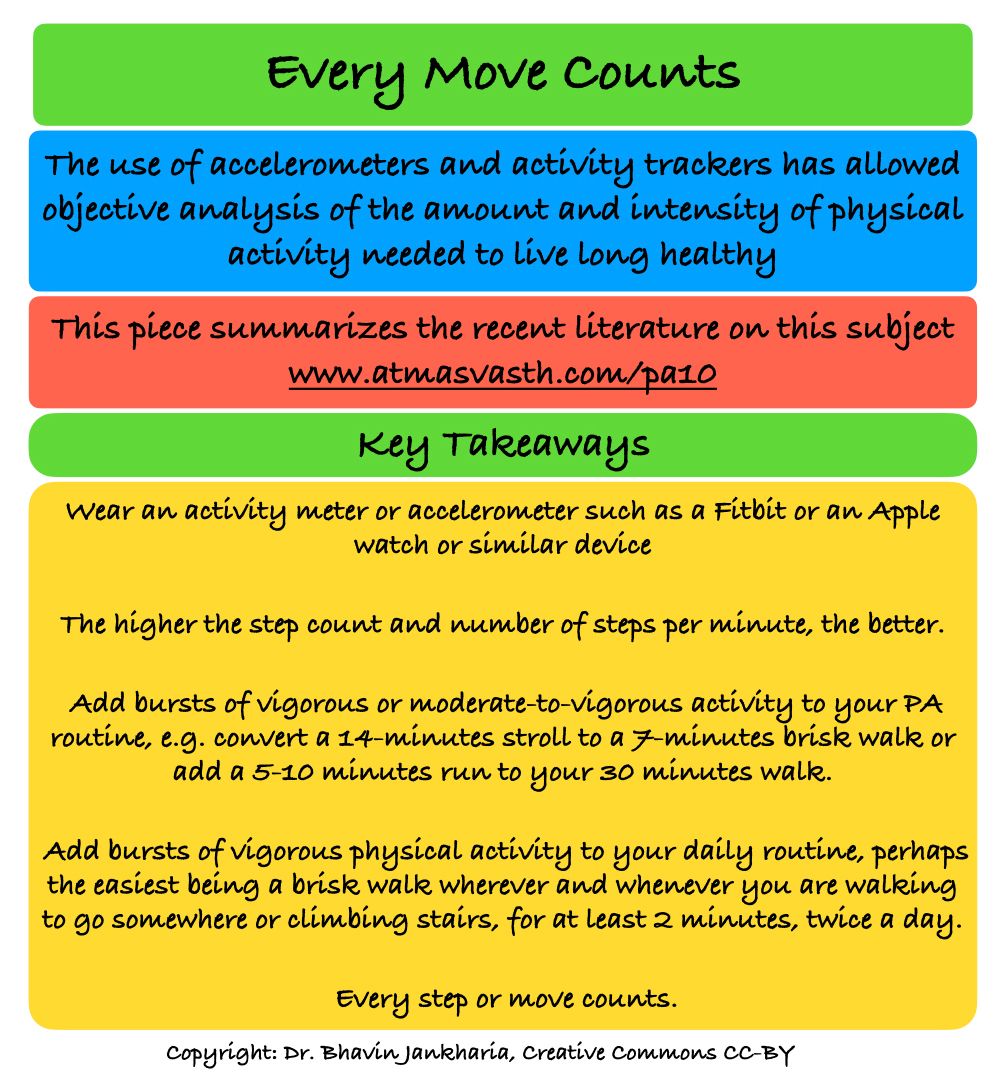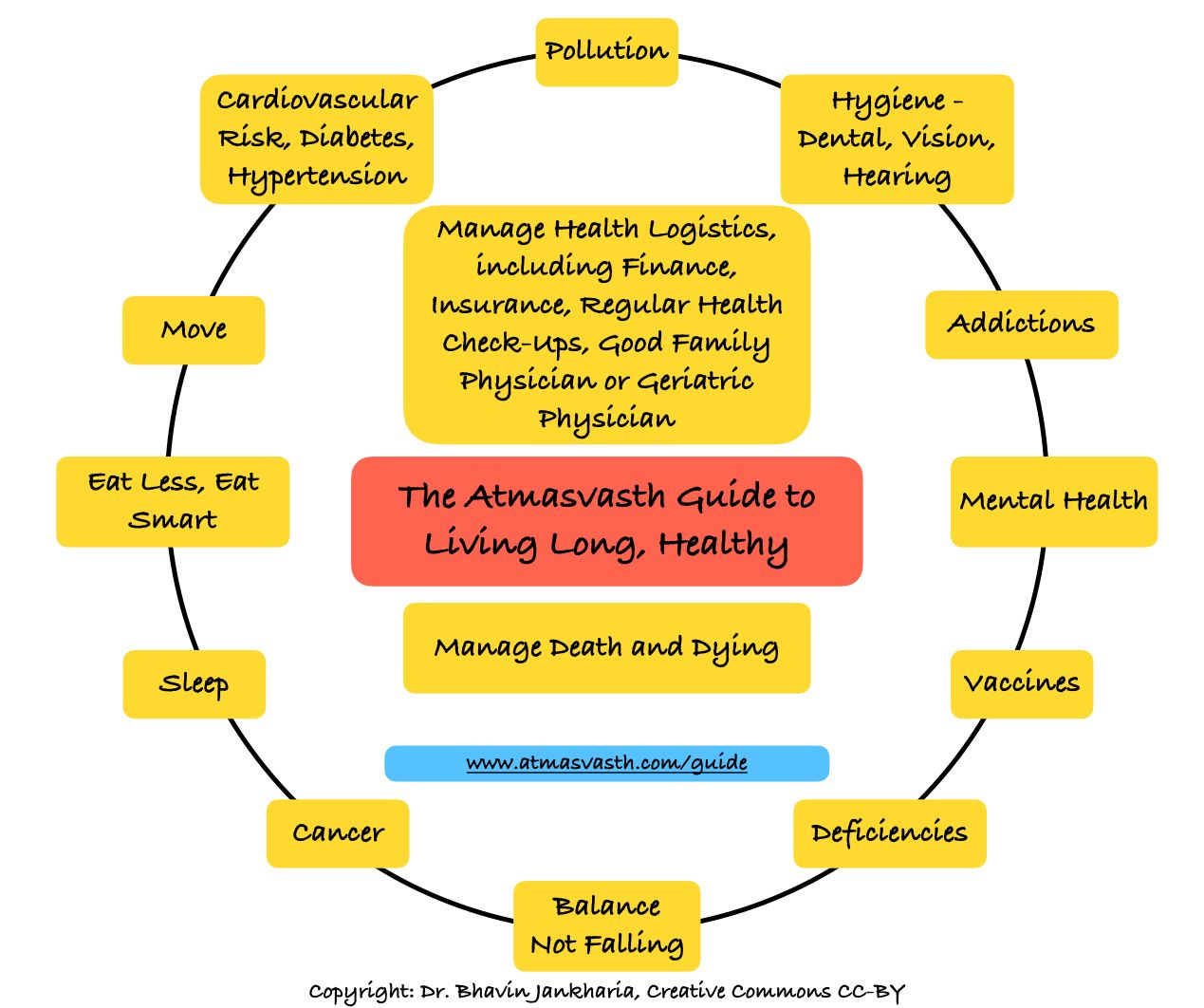Every Move Counts
Every move and step counts. Accelerometers and activity trackers have made it easier to understand the impact of physical activity on healthspan and lifespan

The WHO in 2020 adopted this slogan, “every move counts” to emphasize that physical activity (PA) in all forms can make a big difference to public health [1], averting up to 5 million (59 lakh) deaths per year globally.
A recent projection study by Santos AC and colleagues [2] estimated that physical inactivity will cause 499.2 million (49.9 crore) new non-communicable diseases (NCDs) between now and 2030 with significant costs to individuals and governments…all potentially preventable.
A quarter of the adult population in the world is physically inactive [3] as defined by the WHO guidelines of 150-300 minutes of moderate physical activity per week. In India, it may be as much as 50% [4], meaning that half the adult population in our country does not engage in walking for 30-45 minutes, 5 times a week or a similar activity.
The WHO guidelines are based on studies that used subjective, self-reported questionnaires of physical activity. People are known to significantly overestimate or sometimes even underestimate their physical activity levels. An objective assessment of PA would lead to more accurate studies. In the last decade, the use of accelerometers/activity trackers (Fitbit, Apple Watch, etc) has done just that…allowed a better and more granular understanding of the amount and intensity of physical activity required to increase healthspan and lifespan.
We have already looked at research on “steps”, which shows that increasing the number of steps per day is associated with reduced mortality and reduced incidence of many diseases. An umbrella analysis by Keenan Ramsey and colleagues [5] re-emphasized that “every step counts”, that any activity is better than none and an increasing step count not only improves healthspan and lifespan, it also improves measures of frailty and thus quality of life.
Cadence (number of steps/minute) also matters. A UK Biobank study by Borja del Bozo Cruz and colleagues [6] showed that the higher the steps/minute, the better were the clinical outcomes for the same number of steps, which basically means that whenever possible, the brisker you walk, the better it is. Another similar study by Paddy Dempsey and colleagues [7] looked at physical activity volumes and intensity and found that moderate-to-vigorous physical activity (MVPA) bouts improved cardiovascular outcomes. For example converting a 14-minutes stroll to a 7-minutes brisk walk led to a 14% reduction in cardiovascular disease rate. This implies that you can reduce the amount of time needed to exercise, if you increase intensity, which was further emphasized in a study by Matthew Ahmadi and colleagues [8] that showed that 15 minutes/week of vigorous physical activity (VPA), e.g. running, was associated with a 16-18% lower all-cause and cancer mortality, while 20 minutes/week was associated with 40% lower cardiovascular disease mortality with further benefits up to 50-57 minutes/week. This means two things; the first that we perhaps need lesser amount of physical activity (WHO guidelines mention 75-150 minutes of VPA per week) when we measure objectively and that if we just run for 5-10 minutes each time we go out for a walk, daily or once in two days, it will make a big difference.
Last year I wrote about a study that showed that those who danced and walked demonstrated white matter plasticity and a reduction in the rate of white matter deterioration on MRI. An interesting study by Fabienne Fox and colleagues [9] compared the levels of physical activity among participants of the Rhineland study with MRI measured brain volumes and showed that the higher the activity level, the more were the brain volumes, grey matter densities and cortical thicknesses. In older individuals above the age of 65, even light activity was good enough to improve these MRI brain parameters. The study did not look at whether this correlated with improved cognition and reduced dementia, but there are other studies that I wrote about last year that have shown a direct connection between PA and improved cognition.
The last and most interesting paper of this piece is the one by Emmanuel Stamatakis and colleagues [10] on vigorous intermittent lifestyle physical activity (VILPA), research made possible because of the availability of activity trackers/accelerometers. VILPA was measured in non-exercisers - these are activities that involve a sudden vigorous burst of walking or running or climbing stairs for up to 2 minutes as part of daily activities and not as part of a structured exercise or PA program. They found that a median of 4.4 minutes of VILPA was associated with a 26-30% reduction in all-cause and cancer mortality and a 32-34% reduction in cardiovascular disease mortality.
While accelerometers and activity trackers have changed the physical activity research landscape, it is not clear whether they help at an individual level. An umbrella review by Ty Ferguson and colleagues [11] concluded that activity trackers do make a difference; they help people increase their activity levels and this benefit is clinically important and sustained over time.
Whew!! What does this mean for you and I?
1. Wear an activity tracker or accelerometer such as a Fitbit or an Apple watch or similar device.
2. The higher the step count and the higher the steps per minute, the better.
3. Add bursts of vigorous or moderate-to-vigorous activity to your PA routine, e.g. convert a 14-minutes stroll to a 7-minutes brisk walk or add a 5-10 minutes run to your 30 minutes walk.
4. Add bursts of vigorous physical activity to your daily routine, perhaps the easiest being a brisk walk wherever you are walking to go somewhere or climbing stairs, for at least 2 minutes, twice or thrice a day.
5. Every step or move counts.
Footnotes
1. https://www.who.int/news/item/25-11-2020-every-move-counts-towards-better-health-says-who
2. Santos AC et al. The cost of inaction on physical inactivity to public health-care systems: a population-attributable fraction analysis. Lancet Glob Health. 2023 Jan;11(1):e32-e39.
3. https://www.who.int/news-room/fact-sheets/detail/physical-activity
4. Sharma D et al. Prevalence and Predictors of Physical Inactivity among Adults - A Cross-Sectional Study. Indian J Community Med. 2022 Jan-Mar;47(1):130-132.
5. Ramsey KA, et al. Every step counts: synthesising reviews associating objectively measured physical activity and sedentary behaviour with clinical outcomes in community-dwelling older adults. Lancet Healthy Longev. 2021 Nov;2(11):e764-e772.
6. Del Pozo Cruz B et al. Prospective Associations of Daily Step Counts and Intensity With Cancer and Cardiovascular Disease Incidence and Mortality and All-Cause Mortality. JAMA Intern Med. 2022 Nov 1;182(11):1139-1148.
7. Dempsey PC et al. Physical activity volume, intensity, and incident cardiovascular disease. Eur Heart J. 2022 Dec 7;43(46):4789-4800.
8. Ahmadi MN et al. Vigorous physical activity, incident heart disease, and cancer: how little is enough? Eur Heart J. 2022 Dec 7;43(46):4801-4814.
9. Fox FAU et al. Association Between Accelerometer-Derived Physical Activity Measurements and Brain Structure: A Population-Based Cohort Study. Neurology. 2022 Sep 13;99(11):e1202-e1215.
10. Stamatakis E et al. Association of wearable device-measured vigorous intermittent lifestyle physical activity with mortality. Nat Med. 2022 Dec;28(12):2521-2529.
11. Ferguson T et al. Effectiveness of wearable activity trackers to increase physical activity and improve health: a systematic review of systematic reviews and meta-analyses. Lancet Digit Health. 2022 Aug;4(8):e615-e626.
All the Previous Physical Activity articles

Atmasvasth Newsletter
Join the newsletter to receive the latest updates in your inbox.



